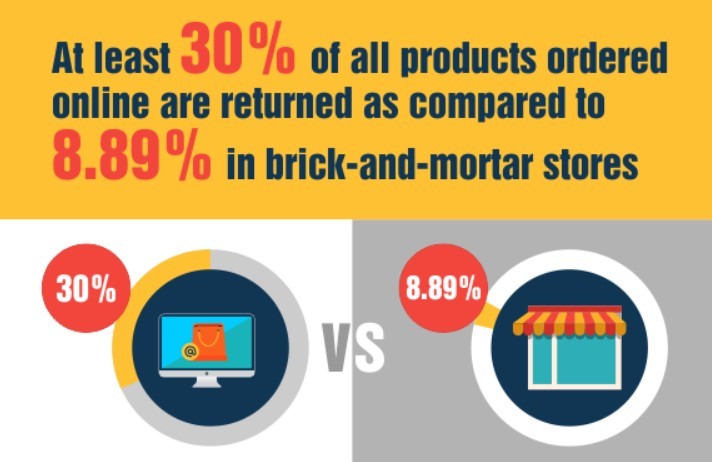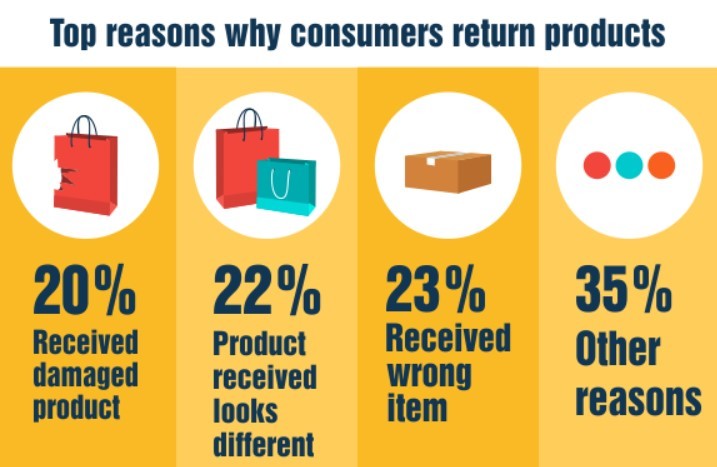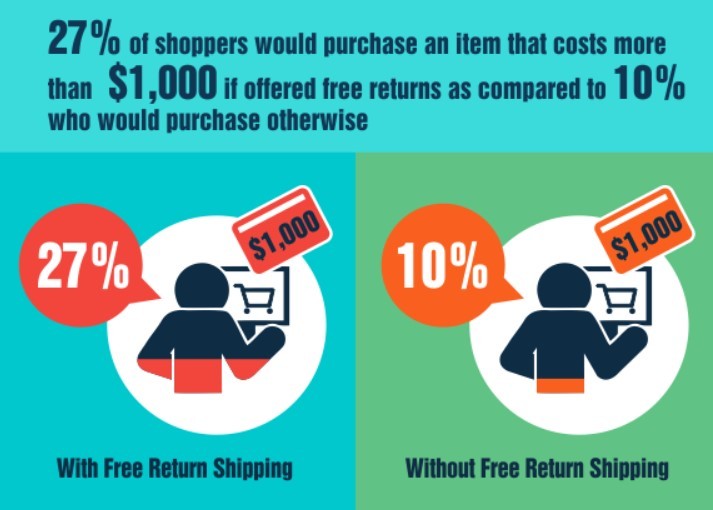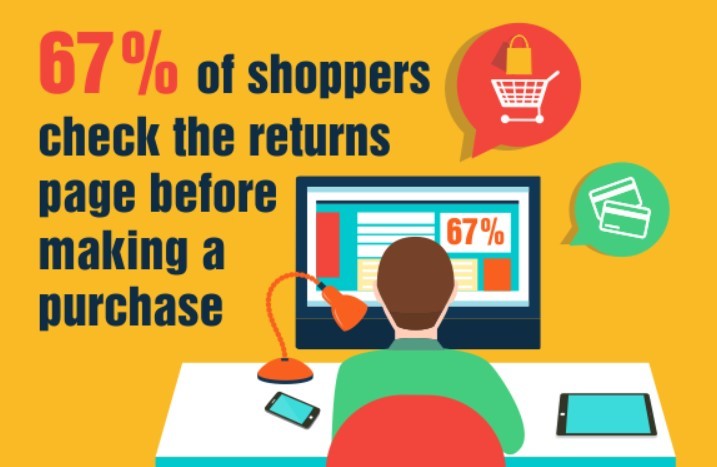
Ecommerce and Retail

For businesses operating in the online retail space, there is one very common and vexing problem that’s the source of many a sleepless night – RETURNS. If this is you, then it’s time to face your nemesis and figure out the best way to deal with your returns effectively.
One thing to remember is that your returns policy can’t be an afterthought – it’s actually a core part of your business and will affect both your before and after-purchase customer experience.
Let us explain…
67% of online shoppers will check the returns page of an ecommerce website before they purchase. After all, they can’t touch your product so they need the assurance of a robust returns policy so they can weigh up the ‘risks’ associated with purchasing. If they don’t like what they see, there goes your sale.
What’s more, 92% of consumers will buy something again if the return process is easy. So it’s an easy win for your customer service reputation but conversely, if a return is poorly handled, your customer satisfaction will suffer – you don’t need that kind of social media attention!
Before we go into the details of ecommerce returns management, it’s best to start with:
According to the governing body, the ACCC, under Australian Consumer Law there is an automatic Consumer Guarantee applied to every product and service, which stipulates that the product or service will work, and it is what the consumer asked for. If not, the consumer has a right to request a repair, a replacement or a refund. If it’s considered a minor problem the business can choose to give a free repair.
As you’re no doubt aware, in the ecommerce world, returns quite often come down to other issues which are unique to the online domain. Approximately 30% of all purchases ordered online are returned, compared to just 9% in traditional brick-and-mortar stores. If we press a little further, 20% of returns are because the product is damaged, 22% is because the items looks different to expected, 23% actually received the wrong item in the first place and 35% is other reasons – let’s just call them ‘the wrong fit’.

Before we delve into your returns and exchange policy, let’s see if we can’t avoid a few in the first place!
This is a fairly obvious one and begins with checking your packaging methods. Some breakages will be a one-off accident but if you start seeing a pattern, investigate and sort it out before it costs you dearly. Perhaps you need to upgrade from a bag to a box, or add some extra cushioning. It’s also worth turning the magnifying glass on your shipping company. Just bring it to their attention initially, and then start tracking incidents to see if there’s a pattern.

While it might be difficult to understand what some people see and expect from online shopping there are a few tried and tested ways to ensure your online product listing is as close to reality as possible.
Imagery – It really does pay to invest in professional photography. Every product should be photographed on a white background from every angle. But don’t stop there, show your product being used and if it comes in multiple colors get a shot of each.
Product description – Once again, more is more. Include every relevant detail a customer might want to know but use bullet points to get your message across succinctly. We wrote about the importance of bullet points for Amazon listings, and what to include in our recent post on optimising your product listing.
Sizing – Provide all relevant dimensions including height, width, capacity and weight. And if it’s apparel be sure to include an accurate sizing guide and details of whether it’s a fitted or loose fit.
And whatever you do, be accurate and honest.
This one falls squarely in your court and while accidents do happen, it might be time you took a closer looking at your picking and packing methods. If your business has grown quickly, your processes may have been left behind and automated picking and packing software can help smooth the way.
You may never know the reasons behind some returns but try to find out and start gathering data. Is there a supplier issue or a consistent problem that can be fixed with a manual or a change in your listing? Hopefully you’ll identify at least some fixes.
Now that you’ve limited the number of returns you’re dealing with, it’s time to create your returns, exchanges and refunds policy and management.
Quite simply it comes down to three choices:
3. Or you both pay a portion of shipping – this usually means the customer pays a flat rate and you pick up the balance. It’s a nice way to build your customer’s confidence without costing too much.
When deciding on a shipping option you might like to consider what your standard shipping price strategy looks like. If you offer free shipping, your customer might be more open to paying for returns and vice versa. And if you offer a flat rate, it makes sense that returns are also a flat rate. It’s also worth checking out what your competitors are up to and decide whether you need to match their policy.
There is one school of thought that believes the more risk you take out of the purchase process the more returns you’ll receive. So if you’re offering free shipping all round it may mean more returns. But… it should also mean more sales, so it’s a fine balancing act that may require a little trial and error. Just remember that if you start offering free shipping and decide to start charging at a later date, you may lose customers in the process, so it might be best to start conservative.

When handling returns you also need to consider packaging. Is it possible for your customer to return the box or package you sent the item in? Should you include a satchel in all orders for returns? If you’re offering free returns, you can include a prepaid label or satchel in the order paperwork that gets sent out to customers.
Be as detailed as possible in your Returns Policy about what’s covered and what isn’t and include a step-by-step process for customers to follow. This procedure should include sending you an email so they can receive an RMA (return merchandise authorization) number to record on their return.

Also define a time limit on returns and keep in mind that customers will always leave it to the last minute so a shorter timeframe works best for you. At Christmas time, you might like to be a little more lenient and offer a longer window for returns and be sure to use this cleverly in your marketing. As for sale items, it’s not uncommon to refuse returns altogether (unless the item is faulty).
When it comes to the return or exchange mechanism, don’t be scared to offer options other than a cash refund. Mention exchanges, store credits or gift cards as options. Speaking of stores, if you operate a bricks and mortar store as well as online, be sure to specify in your policy as to whether returns can be made in store. This option tends to keep everyone happy so long as your staff are well-trained in the process so that they can handle the return on the spot and keep your customer satisfied.
If you’re an omni-channel business you’ll be handling returns across multiple marketplaces so the best idea is to keep it consistent with your standard policy and save any confusion for you or your customer.
For both eBay and Amazon, returns are handled within the marketplace framework rather than directly and how well you handle the process will affect your overall customer rating. They also have certain expectations on return policies but these are just a guideline and they stipulate that it may vary for third party sellers.
Returns may not be an ecommerce business’ best friend but there is good reason to embrace the process. As mentioned, it’s core to your business and affects current and future sales. You should recognize that returns offer an opportunity for you to make sales, strengthen customer relationships and build your reputation and profile.
If you're looking for an inventory management system that nicely handles returns, check out Neto Inventory.
Further reading: Shipping and Order Fulfilment for Ecommerce